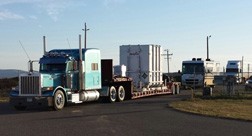Satellite to Provide CO2 Data
- Share
- Tweet
- Pin
- Share

A truck convoy carrying NASA’s Orbiting Carbon Observatory-2 spacecraft arrives at California’s Vandenberg Air Force Base on April 30. The observatory will undergo final tests in preparation for a planned July 1 launch. Photo courtesy of NASA/JPL-Caltech.
A NASA spacecraft designed to make precise measurements of carbon dioxide in Earth’s atmosphere is at Vandenberg Air Force Base, Calif., to begin final preparations for launch.
The Orbiting Carbon Observatory-2 arrived April 30 at its launch site on California’s central coast after travelling from Orbital Sciences Corp.’s Satellite Manufacturing Facility in Gilbert, Ariz. The spacecraft now will undergo final tests and then be integrated on top of a United Launch Alliance Delta II rocket in preparation for a planned July 1 launch.
The observatory is NASA’s first satellite mission dedicated to studying carbon dioxide, a critical component of Earth’s carbon cycle that is the leading human-produced greenhouse gas driving changes in Earth’s climate. It replaces a nearly identical spacecraft lost due to a rocket launch mishap in February 2009.
OCO-2 will provide a new tool for understanding both the sources of carbon dioxide emissions and the natural processes that remove carbon dioxide from the atmosphere and how they are changing over time.
The observatory will fly in a 438-mile altitude, near-polar orbit in formation with the five other satellites that are part of the Afternoon, or “A-Train” Constellation. This international constellation of Earth-observing satellites circles Earth once every 98 minutes in a sun-synchronous orbit that crosses the equator near 1:30 pm local time and repeats the same ground track every 16 days. OCO-2 will be inserted at the head of the A-Train. Once in this orbit, OCO-2 is designed to operate for at least two years.


